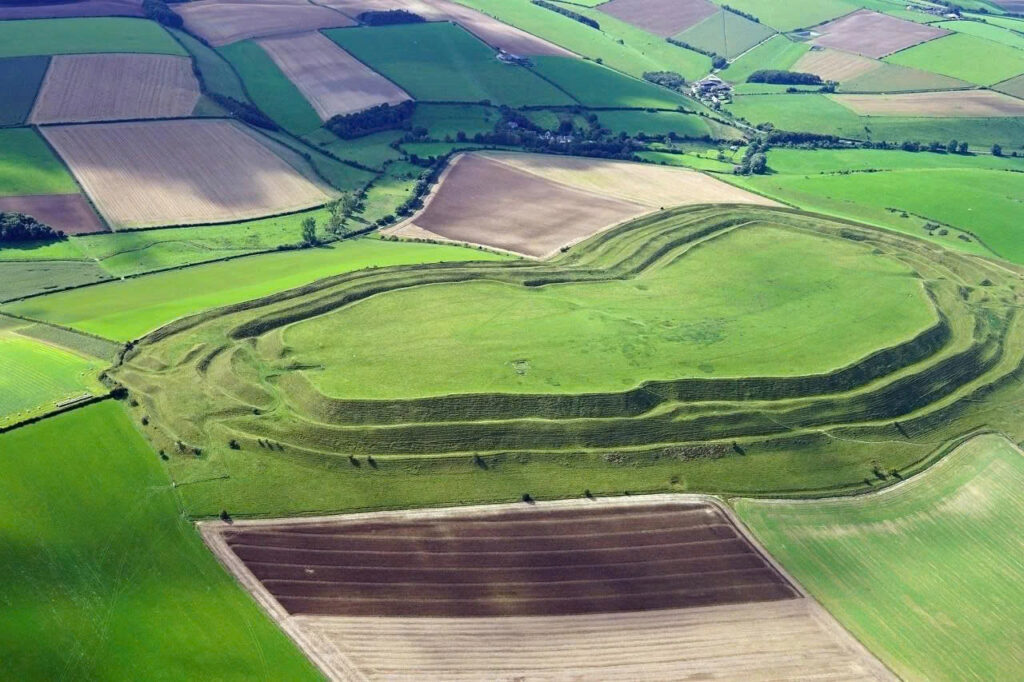A groundbreaking archaeological study has revealed surprising new insights about one of Britain’s most famous ancient sites, challenging long-held beliefs about its dramatic past and offering a fresh perspective on Iron Age history.
The Site That Captivated Historians
Maiden Castle, an impressive Iron Age hillfort in Dorset, has fascinated archaeologists and historians since the 1930s. This massive fortification, with its towering earthwork defenses, was thought to be the scene of a decisive confrontation during Britain’s ancient period. For nearly a century, scholars believed they had uncovered evidence of a single, devastating encounter that marked the end of local resistance.

A Famous Discovery Gets a Second Look
The original excavation in 1936, led by renowned archaeologist Sir Mortimer Wheeler, uncovered dozens of human remains showing clear signs of conflict-related injuries. Wheeler’s interpretation of these findings painted a vivid picture of heroic local defenders making their final stand against invading forces. This compelling narrative, discovered during a time when Britain itself faced external threats, resonated deeply with both academic circles and the public imagination.
Modern Science Reveals New Truths
Advanced Dating Techniques Change Everything
Researchers from Bournemouth University have now applied cutting-edge radiocarbon dating methods to re-examine the remains. Their findings, published in the prestigious Oxford Journal of Archaeology, tell a remarkably different story. Rather than representing a single dramatic event, the evidence suggests these individuals lived and died across several decades, spanning from the late first century BCE to the early first century CE.

Dr. Martin Smith, Associate Professor of Forensic and Biological Anthropology at Bournemouth University, explained the significance of this discovery: “While the presence of numerous individuals with weapon-related injuries was never disputed, our systematic dating program has revealed that these deaths occurred over an extended period rather than during one catastrophic incident.”
A More Complex Historical Picture
The new evidence points to a series of separate conflicts rather than one decisive encounter. These may have involved internal disputes, leadership struggles, or regional enforcement actions – painting a picture of a society dealing with ongoing tensions and power dynamics rather than external invasion.
Dr. Miles Russell, the university’s Principal Academic in Prehistoric and Roman Archaeology, emphasized how this changes our understanding: “For decades, the story of this site has been central to our understanding of ancient British resistance. However, the archaeological evidence now suggests a more complex reality involving local conflicts rather than foreign conquest.”
Implications for Understanding Ancient Britain
Rethinking Archaeological Interpretation
This discovery has broader implications for how historians interpret ancient burial sites across Britain. The research team found evidence of diverse burial practices at Maiden Castle, suggesting either multiple cultural groups coexisting or sophisticated social structures that influenced funeral customs.

Paul Cheetham, a Visiting Fellow at Bournemouth University, noted the complexity revealed by their study: “The original excavation, while excellent for its time, only examined a small portion of this vast site. Our findings show that simplistic interpretations of ancient burial grounds need to be reconsidered, as the mixing of different cultural practices suggests a more nuanced social reality.”
Uncovering Hidden Stories
The research suggests that many more burials likely remain undiscovered around the massive earthwork defenses. Each potential discovery could add new layers to our understanding of how ancient communities lived, died, and commemorated their members.
Video
A New Chapter in British History
Moving Beyond Heroic Narratives

This study demonstrates how modern archaeological techniques can challenge even well-established historical narratives. While the original interpretation provided a compelling story of resistance and heroism, the new evidence reveals a more complex reality of internal conflict and social dynamics.
The researchers emphasize that this doesn’t diminish the historical importance of Maiden Castle – rather, it reveals a more nuanced picture of Iron Age British society, with its own internal struggles and complexities.
Lessons for Modern Archaeology
This case study highlights the importance of continually re-examining archaeological evidence with new techniques and fresh perspectives. As Dr. Russell noted, “While many historical injustices certainly occurred during ancient times, it’s crucial that we base our understanding on solid evidence rather than assumptions.”

The Maiden Castle research serves as a reminder that history is often more complicated than initial interpretations suggest, and that ongoing archaeological work continues to refine and improve our understanding of the past.
Conclusion
The reinterpretation of Maiden Castle’s “war cemetery” represents a significant shift in understanding one of Britain’s most famous archaeological sites. Rather than a single moment of dramatic confrontation, the evidence now points to decades of internal conflict and social complexity. This discovery not only changes how we view this particular site but also encourages archaeologists to approach other ancient burial grounds with more nuanced perspectives, recognizing that the stories they tell may be far more complex than initially apparent.

